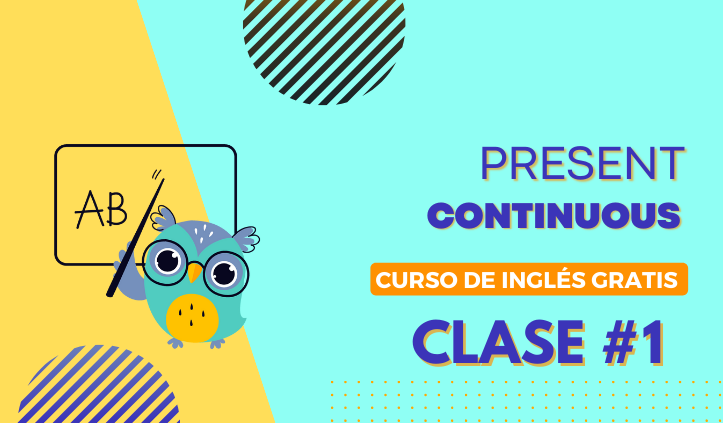El Present Continuous es un tiempo verbal muy importante en inglés y se utiliza para hablar de algo que está sucediendo en este momento, situaciones temporales o un futuro cercano.
- Now (ahora)
- Near future (Futuro próximo)
Ejemplo:
I am studying now. (Estoy estudiando ahora) -> ocurriendo ahora (now)
He is working tonight. (Él estará trabajando esta noche) -> futuro próximo (near future)
Aprende Inglés Ahora: Descubre los mejores cursos de inglés en línea – Haz clic aquí
Además de las dos situaciones mencionadas anteriormente, también utilizamos este tiempo verbal para indicar algo que está cambiando en el momento.
Ejemplo:
The chocolate is melting. (El chocolate se está derritiendo)
They are getting very smart. (Ellos se están volviendo muy inteligentes)
La estructura de este tiempo verbal en forma afirmativa (affirmative form) se presenta de la siguiente manera:
| Subject (sujeto) + verb to be (verbo to be) + verbo principal con ing + complemento |
| Affirmative form | Forma afirmativa (traducción) |
|---|---|
| I am working. | Estoy trabajando. |
| You are dancing. | Estás bailando. |
| He is studying. | Él está estudiando. |
| She is watching TV. | Ella está viendo la televisión. |
| It is raining. | Está lloviendo. |
| We are travelling. | Estamos viajando. |
| They are writing a letter. | Están escribiendo una carta. |
En las frases negativas (negative form), se agrega «not» después del verbo auxiliar «to be»:
| Subject (sujeto) + verb to be (verbo to be) + not + verbo principal con ing + complemento |
| Negative form | Forma negativa (traducción) |
|---|---|
| I am not working. | No estoy trabajando. |
| You are not dancing./You aren’t dancing. | No estás bailando. |
| He is not studying./He isn’t studying. | Él no está estudiando. |
| She is not watching TV./She isn’t watching TV. | Ella no está viendo la televisión. |
| It is not raining./It isn’t raining. | No está lloviendo. |
| We are not travelling./We aren’t travelling. | No estamos viajando. |
| They are not writing a letter./They aren’t writing. | No están escribiendo una carta. |
En la forma interrogativa (interrogative form), el verbo to be se invierte con el sujeto. Cuando se utilizan preguntas con palabras interrogativas (wh questions) como what, where, which, how, when, etc., se colocan al inicio de la frase.
| Verb to be (verbo to be) + Subject (sujeto) + verbo principal con ing + complemento + ? |
| Interrogative form | Forma interrogativa (traducción) |
|---|---|
| Am I working? | ¿Estoy trabajando? |
| Where are you dancing? | ¿Dónde estás bailando? |
| Is he studying? | ¿Está él estudiando? |
| What is she watching on TV? | ¿Qué está viendo ella en la televisión? |
| Is it raining? | ¿Está lloviendo? |
| When are we travelling? | ¿Cuándo vamos a viajar? |
| Are they writing a letter? | ¿Están ellos/ellas escribiendo una carta? |
Ing rules (reglas del ing)
El uso del “ing” tiene algunas reglas bastante sencillas. ¡Vamos!
1. Verbos terminando con la letra «e» -> La letra e se reemplaza por ing.
Ejemplos:
- to dance = dancing (bailar = bailando)
- to write = writing (escribir = escribiendo)
- to make = making (hacer = haciendo)
2. Verbos terminados en «ie» -> Reemplazar por y + ing.
Ejemplos:
- to die = dying (morir = muriendo)
- to lie = lying (mentir = mintiendo)
- to tie = tying (atar = atando)
3. Verbos terminados en CVC (consonante-vocal-consonante) → duplicar la última consonante y añadir ing
Ejemplos:
- to travel = travelling (viajar = viajando)
- to swim = swimming (nadar = nadando)
Non continuous verbs:
Algunos verbos no aceptan el «-ing» en su estructura. Pueden expresar sentimientos, posesiones o algo abstracto:
- be (ser/estar)
- want (querer)
- need (necesitar)
- exist (existir)
- own (poseer)
- like (gustar)
- love (amar)
- hate (odiar)
- dislike (no gustar)
Las frases con verbos no continuos (non continuous verbs) se mantienen en la estructura del presente simple.
Ejemplos:
She is needing to talk to me. -> She needs to talk to me.
They are wanting to travel. -> They want to travel.
I am liking it. -> I like it.
We are loving this movie. -> We love this movie.
Time expressions
Algunas palabras se utilizan frecuentemente en el present continuous para determinar un tiempo más específico como: now, at the moment, at present, today, tomorrow, tonight, this morning/afternoon/night, this week/month/year.
- I am working today. (Estoy trabajando hoy.)
- She is travelling this week. (Ella está viajando esta semana.)
- They are having dinner tonight. (Ellos están cenando esta noche.)
- He is watching TV at the moment. (Él está viendo la televisión en este momento.)
Espero que hayas disfrutado y aprendido los usos del presente continuo. No dejes de practicar mucho.
See you!

